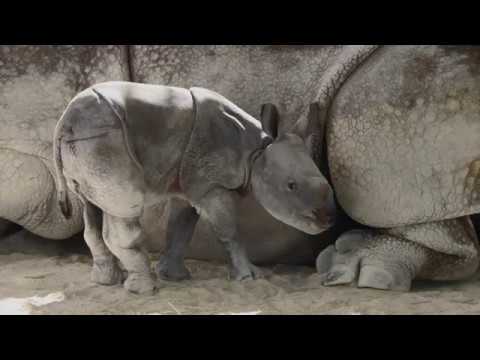On April 22, 2019, after an over 15 month pregnancy, “Akuti,” a 7 year old Greater One Horned Indian Rhinoceros, gave birth at approximately 12:30am! This is only the second successful birth of this very rare species in the zoo’s history. However, what makes this birth truly historic is that it is the first successful birth of this species anywhere in recorded history to be the result of induced ovulation and artificial insemination!!
This is the first baby for Akuti, which means “Princess” in Hindi. She was born at the San Diego Zoo Safari Park in January of 2012 and arrived at Zoo Miami in February of 2016. The father is 18 year old “Suru,” which means “A Start” in Bengali. He was also born at the San Diego Zoo Safari Park and arrived at Zoo Miami in October of 2003.
After several attempts at natural breeding with no success, a special team from the South East Zoo Alliance for Reproduction and Conservation (SEZARC), along with Dr. Monica Stoops from the Cincinnati Zoo, met at Zoo Miami to artificially collect semen from Suru on January 8, 2018, and then artificially inseminated Akuti on January 9, 2018. SEZARC is dedicated to increasing the populations of rare and endangered species through reproductive science and has worked with several zoos and aquariums around the country.
Once we were able to confirm that Akuti had indeed conceived, she was trained to receive regular ultrasound examinations which enabled zoo staff to closely monitor the development of the fetus. Because we knew the exact date of conception, we were able to accurately estimate the birthdate and for the last several days, Akuti has been under 24 hour observation awaiting this very exciting event.
Initial indications are that the newborn is healthy and doing well but more detailed information will not become available until the veterinary team is able to do a neonatal exam. This will be performed when the staff feels that it can safely separate the infant from its very protective mother for the few minutes that the exam will take. It is critical that the mother and newborn are able to establish a bond which can sometimes be a challenge for first time mothers. Because of the extreme sensitivity of the situation, there will be no media access until zoo management has determined that everything is stable and the new mother and baby have been able to adjust. If everything goes well, it will probably be a few weeks until mom and baby are on public display.
There are less than 3,000 Indian rhinos left in the wild occurring in small protected areas of Nepal, India, and Assam. Over the years, they have been poached extensively for their horn which is used for medicinal purposes and for dagger handles that are revered in some Asian cultures. They are the world’s fourth largest land mammal sometimes reaching a weight of 6,000 pounds.
This very rare birth is not only significant for Zoo Miami, it is incredibly important to the international efforts to maintain a healthy population under human care of this highly vulnerable species throughout the world.
Video credit: Ron Magill




